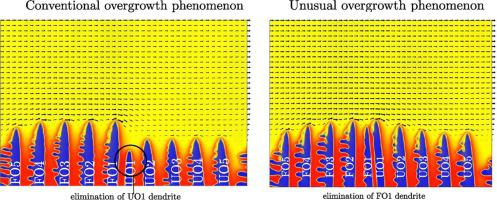当前位置:
X-MOL 学术
›
Comp. Mater. Sci.
›
论文详情
Our official English website, www.x-mol.net, welcomes your
feedback! (Note: you will need to create a separate account there.)
A two-dimensional phase-field study on dendritic growth competition under convective conditions
Computational Materials Science ( IF 3.1 ) Pub Date : 2021-01-01 , DOI: 10.1016/j.commatsci.2020.109964 V. Pavan Laxmipathy , Fei Wang , Michael Selzer , Britta Nestler
Computational Materials Science ( IF 3.1 ) Pub Date : 2021-01-01 , DOI: 10.1016/j.commatsci.2020.109964 V. Pavan Laxmipathy , Fei Wang , Michael Selzer , Britta Nestler

|
Abstract In the present work, the growth competition of columnar dendrites is investigated in the presence of melt convection. By using a multiphase-field model, the microstructural evolution of unidirectionally solidified dendrites with different crystal orientations is addressed in detail. Generally, for converging bicrystal grains, the dendritic growth competition follows a conventional overgrowth model, where a favorably oriented dendrite eliminates an unfavorably oriented dendrite at the grain boundary. However, in the presence of lateral melt flow in the liquid phase, we discover that the conventional overgrowth mechanism transforms into an unusual overgrowth mechanism as the melt velocity gradually increases. Recently observed in bi-crystal studies, the unfavorably oriented dendrites overgrow at the expense of the favorably oriented dendrites during an unusual overgrowth behavior. From our simulations we elucidate that the presence of an additional convective transport in the liquid phase modifies the solute distribution at the grain boundary, which in turn affects the overgrowth mechanism of converging dendrites. We show that there exists a critical melt velocity to determine the growth competition at the grain boundary. In addition, the role of interfacial anisotropy on growth competition is analyzed in detail, where we discern that the conventional overgrowth behavior is dominant at large anisotropic strengths. Lastly, a morphological selection map is depicted to predict the crossover region between the two overgrowth behaviors.
中文翻译:

对流条件下树枝状生长竞争的二维相场研究
摘要 在目前的工作中,研究了熔体对流存在下柱状枝晶的生长竞争。通过使用多相场模型,详细讨论了具有不同晶体取向的单向凝固枝晶的微观结构演变。通常,对于会聚双晶晶粒,枝晶生长竞争遵循常规的过度生长模型,其中有利取向的枝晶消除了晶界处不利取向的枝晶。然而,在液相中存在横向熔体流动的情况下,我们发现随着熔体速度的逐渐增加,传统的过度生长机制转变为不寻常的过度生长机制。最近在双晶研究中观察到,在异常的过度生长行为期间,不利取向的树突过度生长,以牺牲有利取向的树突为代价。从我们的模拟中,我们阐明液相中额外对流传输的存在改变了晶界处的溶质分布,这反过来又影响了会聚枝晶的过度生长机制。我们表明存在一个临界熔体速度来确定晶界处的生长竞争。此外,详细分析了界面各向异性对生长竞争的作用,我们发现传统的过度生长行为在大的各向异性强度下占主导地位。最后,描述了形态选择图以预测两种过度生长行为之间的交叉区域。从我们的模拟中,我们阐明液相中额外对流传输的存在改变了晶界处的溶质分布,这反过来又影响了会聚枝晶的过度生长机制。我们表明存在一个临界熔体速度来确定晶界处的生长竞争。此外,详细分析了界面各向异性对生长竞争的作用,我们发现传统的过度生长行为在大的各向异性强度下占主导地位。最后,描述了形态选择图以预测两种过度生长行为之间的交叉区域。从我们的模拟中,我们阐明液相中额外对流传输的存在改变了晶界处的溶质分布,这反过来又影响了会聚枝晶的过度生长机制。我们表明存在一个临界熔体速度来确定晶界处的生长竞争。此外,详细分析了界面各向异性对生长竞争的作用,我们发现传统的过度生长行为在大的各向异性强度下占主导地位。最后,描述了形态选择图以预测两种过度生长行为之间的交叉区域。这反过来又会影响会聚枝晶的过度生长机制。我们表明存在一个临界熔体速度来确定晶界处的生长竞争。此外,详细分析了界面各向异性对生长竞争的作用,我们发现传统的过度生长行为在大的各向异性强度下占主导地位。最后,描述了形态选择图以预测两种过度生长行为之间的交叉区域。这反过来又会影响会聚枝晶的过度生长机制。我们表明存在一个临界熔体速度来确定晶界处的生长竞争。此外,详细分析了界面各向异性对生长竞争的作用,我们发现传统的过度生长行为在大的各向异性强度下占主导地位。最后,描述了形态选择图以预测两种过度生长行为之间的交叉区域。
更新日期:2021-01-01
中文翻译:

对流条件下树枝状生长竞争的二维相场研究
摘要 在目前的工作中,研究了熔体对流存在下柱状枝晶的生长竞争。通过使用多相场模型,详细讨论了具有不同晶体取向的单向凝固枝晶的微观结构演变。通常,对于会聚双晶晶粒,枝晶生长竞争遵循常规的过度生长模型,其中有利取向的枝晶消除了晶界处不利取向的枝晶。然而,在液相中存在横向熔体流动的情况下,我们发现随着熔体速度的逐渐增加,传统的过度生长机制转变为不寻常的过度生长机制。最近在双晶研究中观察到,在异常的过度生长行为期间,不利取向的树突过度生长,以牺牲有利取向的树突为代价。从我们的模拟中,我们阐明液相中额外对流传输的存在改变了晶界处的溶质分布,这反过来又影响了会聚枝晶的过度生长机制。我们表明存在一个临界熔体速度来确定晶界处的生长竞争。此外,详细分析了界面各向异性对生长竞争的作用,我们发现传统的过度生长行为在大的各向异性强度下占主导地位。最后,描述了形态选择图以预测两种过度生长行为之间的交叉区域。从我们的模拟中,我们阐明液相中额外对流传输的存在改变了晶界处的溶质分布,这反过来又影响了会聚枝晶的过度生长机制。我们表明存在一个临界熔体速度来确定晶界处的生长竞争。此外,详细分析了界面各向异性对生长竞争的作用,我们发现传统的过度生长行为在大的各向异性强度下占主导地位。最后,描述了形态选择图以预测两种过度生长行为之间的交叉区域。从我们的模拟中,我们阐明液相中额外对流传输的存在改变了晶界处的溶质分布,这反过来又影响了会聚枝晶的过度生长机制。我们表明存在一个临界熔体速度来确定晶界处的生长竞争。此外,详细分析了界面各向异性对生长竞争的作用,我们发现传统的过度生长行为在大的各向异性强度下占主导地位。最后,描述了形态选择图以预测两种过度生长行为之间的交叉区域。这反过来又会影响会聚枝晶的过度生长机制。我们表明存在一个临界熔体速度来确定晶界处的生长竞争。此外,详细分析了界面各向异性对生长竞争的作用,我们发现传统的过度生长行为在大的各向异性强度下占主导地位。最后,描述了形态选择图以预测两种过度生长行为之间的交叉区域。这反过来又会影响会聚枝晶的过度生长机制。我们表明存在一个临界熔体速度来确定晶界处的生长竞争。此外,详细分析了界面各向异性对生长竞争的作用,我们发现传统的过度生长行为在大的各向异性强度下占主导地位。最后,描述了形态选择图以预测两种过度生长行为之间的交叉区域。











































 京公网安备 11010802027423号
京公网安备 11010802027423号